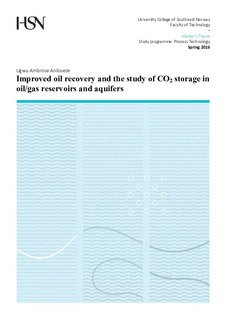| dc.description.abstract | As the world’s energy needs grow, several techniques have been introduced for an improved oil recovery (IOR) and secured storage of CO₂. Such techniques include the use of water injection, CO₂ for Enhanced Oil Recovery (EOR) and the application of inflow control devices (ICD) with the aim to maximize production and improve well performance. To meet global energy demand with the instability in oil price, these IOR techniques through advanced well completion and stimulation techniques have enabled commercial production in reservoirs previously abandoned by traditional recovery methods.
One of the objectives of this work is to ascertain the optimal water injection arrangement between vertical and horizontal water injection using ECLIPSE. Within this work, analyses of oil production, water breakthrough and pressure over simulation time were made. These analyses cover both cases of horizontal and vertical waterflooding in a homogeneous and a heterogeneous reservoir. In the results, it shows that the horizontal waterflooding provides longer delay in water breakthrough and increase in oil production. The increase in oil recovery achieved varies between 6% and 36% while the delay in breakthrough varies between 459 days and 1362 days.
This work also presents the mathematical models used for the implementation of ICD in ECLIPSE. A case study using reservoir conditions similar to Troll offshore Norway was simulated to illustrate the effect of ICD in a heterogeneous reservoir. The simulation result shows that with ICD completion, water breakthrough could be delayed for 262 days and water cut after 3000 days reduced by 11%. Despite the delay in water breakthrough, the oil production rate decreased. Although well productivity is reduced by approximately 42%, there is an improved degree of inflow equalization through ICD completion. Gas production was decreased by approximately 51% with ICD completion.
In addition to using CO₂ for EOR, it is crucial to store CO₂ to avoid the large contribution to global warming. It has been revealed that about 120 Giga tons of CO₂ would need to be captured and stored between 2015 and 2050 globally. Mature oil reservoirs and underlying aquifers are considered as the future solution for CO₂ storage. In this work, literature study was carried out to have a better understanding of the storage capacity and suitability for CO₂ storage in oil/gas reservoirs and aquifers. The study shows that residual gas trapping and the dissolution in water give greater contribution to CO₂ storage than the structure trapping mechanism. | nb_NO |
